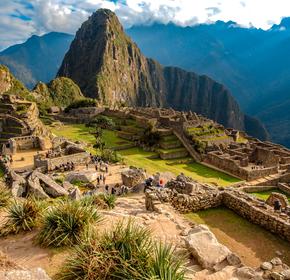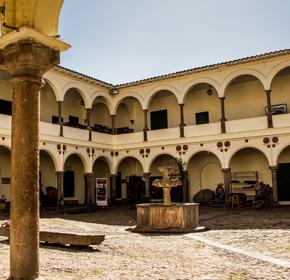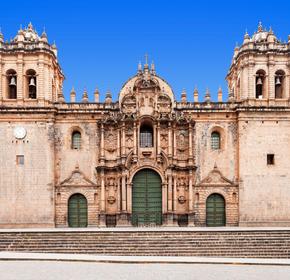
Cusco travel guide
Cusco Tourism | Cusco Guide
You're Going to Love Cusco
Cusco is located in the southeastern part of Peru, high up in the Andes mountains (11,200 feet above sea level to be exact). Cusco was the capital of the Inca Empire from the 1200s until the arrival of Spanish colonizers in the 1500s. Here, you'll be vacationing in a UNESCO World Heritage Site.
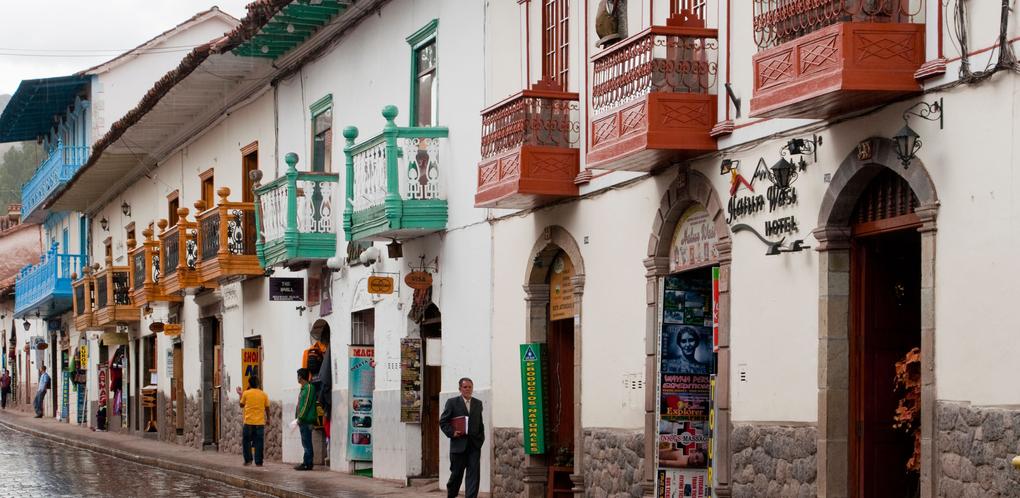
The Inca Empire was a rich and fascinating one, and you'll find many examples of its culture. The Coricancha is where Inca and Spanish civilization meet. The site was a revered Incan temple to the sun god. When the Spanish built the Convent of Santo Domingo above it, they incorporated the original stonework.
The surrounding Sacred Valley incorporates the renowned ruins of Machu Picchu, neighboring towns, and farmlands in a region that was the center of the Inca Empire. You'll also discover a hot nightlife and dining scene with cosmopolitan flair tucked away in this sky-high destination.
Top 5 Reasons to Visit Cusco
1. Machu Picchu
The remains of this walled citadel and imperial residence are located on a mountain ridge nearly 8,000 feet above sea level. As the Spanish took over the area, the Inca kept its location a secret, and in fact it was not rediscovered until 1911. The three buildings were made of stone and include a temple, with terraced grounds along the slope, and an old Inca road that leads you to it.
2. Ruins and More Ruins
Before the Inca, the area was home to the Killke culture, and the Killke built the ruins of Saksaywaman, a citadel complex made of large cut stones, in about 1100. The most popular Inca ruins, along with Machu Picchu, are the remains of an imperial residence along the mountainside at Ollantaytambo. To avoid crowds, you can try the Inka Wasi, higher up the mountainside, or the sculpture garden at Nusta Hisp'ana.
3. Spanish Architecture
The Plaza de Armas and Cathedral of Cusco are prime examples of ornate Spanish colonial architecture, characterized by arches and balconies. A walk down the streets and an afternoon spent in a patio cafe is all you need to enjoy this aspect of life in Cusco.
4. The Andes
Many visitors come to Cusco to experience the Andes, including hiking and rock climbing. You'll have to book your guide for the Inca Trail to Machu Picchu, as the government limits the number of people allowed each year. It is well worth the effort, however, as you'll pass by several other ruins, and various natural areas including cloud forests and alpine tundra.
5. The Food
The influx of tourists from all over the world gives Cusco cuisine a global perspective and has attracted top chefs. There is an emphasis on local and Peruvian ingredients that comes out in imaginative fare like Italian-Peruvian fusion cuisine and there is a sizable Asian contingent to sample on too.
What to do in Cusco
1. Machu Picchu Historic Sanctuary: Wonder of the New World
Machu Picchu will forever remain Peru's greatest gem. Every day, humbled visitors let their imaginations run wild as they explore these mysterious ruins. Archaeologists continue to restore the Incan complex, rediscovering the organization of the city into temples, urban centers, sacred stones and more. A visit brings back an immersive, mindblowing world of the past.
2. Plaza de Armas: Colonial Architecture
Though the city of Cusco was once the capital of the Inca Empire, this square is the product of the Spanish invasion. Visitors will find colonial paintings hung in the vast Cusco Cathedral, many painted by Inca students in an effort to impose Christian ideals on the Indigenous. The Church of the Company of Jesus is also on the Plaza, underscoring the historical importance of religion. Meanwhile, the Museum of Popular Art invites visitors back to the present with a lighter touch.
3. Saksaywaman: Ancient Lego
Before the Inca conquered this region of Peru, the Killke people occupied the territory. Their greatest legacy is the 12th century Saqsaywaman citadel, an incredible feat of construction built from massive boulders and without any mortar. These great carved stone slabs fit together perfectly and rise out of the arid landscape in a spectacular display. It remains a mystery how the Killke manoeuvred these 200-ton stones into place; a miracle you have to see for yourself.
4. Coricancha: Lost Temple
Dedicated to the Sun God Inti, this Inca temple was beloved throughout the Empire. It was so important, in fact, that the floors and walls were plated in pure gold. The remains of this opulent history were sadly ransacked by the Spanish and INSERT IGNOREd with a church. The incredible stonework of the Inca at the foundation is still to be appreciated. An archaeological museum below the site recognizes the history of the temple and houses relics from within, from mummies to sacred idols.
5. Museo Inka: The Preservation of an Empire
Built upon Inca grounds, the museum celebrates the culture and history of the Inca Empire. These people were incredible craftsmen, and their creations have been preserved within these walls. Visitors will be stunned by the opulence of the gold work, textiles and jewelry, and intrigued by the tradition of mummification and idolatry. Outside, in the museum's courtyard, Andean weavers display their skill and offer their handicrafts for sale.
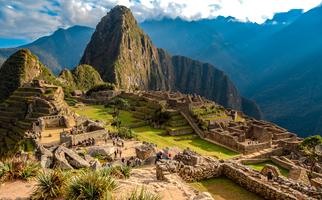
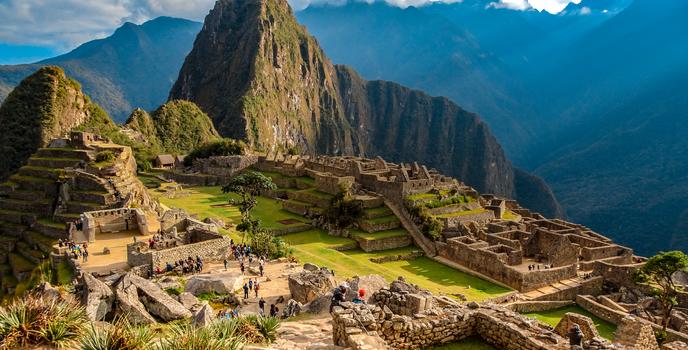






1. Machu Picchu Historic Sanctuary: Wonder of the New World
Machu Picchu will forever remain Peru's greatest gem. Every day, humbled visitors let their imaginations run wild as they explore these mysterious ruins. Archaeologists continue to restore the Incan complex, rediscovering the organization of the city into temples, urban centers, sacred stones and more. A visit brings back an immersive, mindblowing world of the past.
2. Plaza de Armas: Colonial Architecture
Though the city of Cusco was once the capital of the Inca Empire, this square is the product of the Spanish invasion. Visitors will find colonial paintings hung in the vast Cusco Cathedral, many painted by Inca students in an effort to impose Christian ideals on the Indigenous. The Church of the Company of Jesus is also on the Plaza, underscoring the historical importance of religion. Meanwhile, the Museum of Popular Art invites visitors back to the present with a lighter touch.
3. Saksaywaman: Ancient Lego
Before the Inca conquered this region of Peru, the Killke people occupied the territory. Their greatest legacy is the 12th century Saqsaywaman citadel, an incredible feat of construction built from massive boulders and without any mortar. These great carved stone slabs fit together perfectly and rise out of the arid landscape in a spectacular display. It remains a mystery how the Killke manoeuvred these 200-ton stones into place; a miracle you have to see for yourself.
4. Coricancha: Lost Temple
Dedicated to the Sun God Inti, this Inca temple was beloved throughout the Empire. It was so important, in fact, that the floors and walls were plated in pure gold. The remains of this opulent history were sadly ransacked by the Spanish and INSERT IGNOREd with a church. The incredible stonework of the Inca at the foundation is still to be appreciated. An archaeological museum below the site recognizes the history of the temple and houses relics from within, from mummies to sacred idols.
5. Museo Inka: The Preservation of an Empire
Built upon Inca grounds, the museum celebrates the culture and history of the Inca Empire. These people were incredible craftsmen, and their creations have been preserved within these walls. Visitors will be stunned by the opulence of the gold work, textiles and jewelry, and intrigued by the tradition of mummification and idolatry. Outside, in the museum's courtyard, Andean weavers display their skill and offer their handicrafts for sale.








Where to Eat in Cusco
You'll enjoy the diverse dining scene in Cusco, including many Indian, Italian, and Japanese offerings along with local Andean cuisine. Organika is the place to find gourmet Peruvian fusion with mains that start at about S/15. Cicciolina's fine dining menu features both Andean and Italian influences, with main dishes starting at about S/35. Experience an authentic Peruvian steakhouse at Uchu, where you can choose Alpaca tenderloin along with the beef, starting at S/35.
When to visit Cusco
There are essentially two seasons in Cusco, with a temperate climate and little variation in average temperatures that hover between 60 and 65 degrees Fahrenheit. The dry season from May to August is the most popular with tourists. Temperatures can fall close to freezing overnight and there is often frost, but no snow. The wet season lasts from December to February.
How to Get to Cusco
Plane
Cusco is served by Alejandro Velasco Astete International Airport (CUZ) with both domestic and international flights. The airport is located only about two miles from the city. A taxi should cost about S/35 or so, and with many companies, you will have to negotiate your price in advance. Many international flights also arrive in Jorge Chávez Airport in Lima, where there are bus connections directly to Cusco.
Train
Trains are a very scenic way to travel to and around the Sacred Valley. Trains connect Cusco to other cities in the region, as well as offering direct service to Machu Picchu from the Cusco and Ollantaytambo train stations to the Puente Ruinas station in Aguas Calientes. The ride will take you right to the foot of Machu Picchu. PeruRail also connects Cusco to other sites of interest such as Lake Titicaca and the Colca Canyon.
Car
Cusco connects to the rest of southern Peru, including Lima, via a network of highways. The Pan-American highway connects to the road that leads from Nazca to Abancay and into Cusco. Remember that landslides are a possibility so high up in the Andes, and driving may involve delays or other unforeseen conditions.
Bus
Long distance buses arrive at Terminal Terrestre Cusco in the Santiago neighborhood of town. There are direct connections to Lima and other cities and towns in the region such as La Paz and Puno. Major bus companies include Oltursa, Civa, and Tepsa.
Airlines serving Cusco
Where to stay in Cusco
Plaza de Armas - this area, centered around the classic Spanish colonial architecture of the central square and fountain, is loaded with shops, restaurants, and nightclubs, and is very popular with tourists. It's also where you'll find tour companies that can take to you other locations in the Sacred Valley.
Popular Neighborhoods in Cusco
San Blas - uphill from Plaza de Armas, this is a place where the streets have a bohemian flair and the views are spectacular. It is home to many artists and artisans, and it's where you'll find smaller hotels, restaurants, and a nightlife scene where you can rub shoulders with locals.
Plaza San Francisco - this is where you can shop for local goods and souvenirs at outdoor markets, and take in the beautiful Santa Clara and San Pedro churches that date from the early 17th century. You'll be in awe of the gorgeous ceiling frescoes and collection of art at the Museo y Convento de San Francisco de Asis del Cusco.
Where to stay in popular areas of Cusco
Most booked hotels in Cusco
How to Get Around Cusco
Public Transportation
There is a network of private bus and minivan routes that covers most of Cusco, with connections beyond. Routes center around the Cusco bus station, and the fare within the city is S/0.70.
Taxi
Taxis are cheap and relatively plentiful in Cusco. Along with the Municipalidad del Cusco - Taxi Oficial, there are numerous "unofficial" taxis available in Cusco. A ride within the city of about 10 minutes should cost about S/4-6. Taxis are not metered, which means you will have to negotiate your price and stick to it.
Car
Roads in Cusco are narrow and most are uneven cobblestone, which makes driving an unnecessary luxury. A compact rental should cost about S/55. The city is walkable, and you may need permits and the services of guides for some of the area's historic sites. Parking is limited and often difficult to find, with rates that vary.
The Cost of Living in Cusco
Shopping Streets
Cusco is renowned for its textile industry, and you'll find locally produced clothing and textiles at the Centro de Textiles Tradicionales del Cusco, located in the northern part of town. You'll find many shops offering artisan handicrafts in the San Blas area, and around Plaza de Armas. including silver jewelry and many other wares.
Groceries and Other
Orion and Mega are the two major grocery chains in Cusco. A quart of milk costs about S/4.00 and a dozen eggs is about S/4.60.
